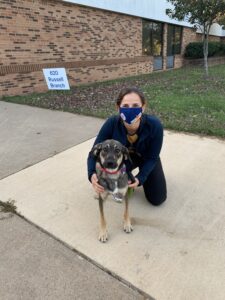
I have adopted a lovely rescue pup named Maleficent and now I am faced with a new challenge: running with a dog. She is a mutt (or ‘poster child for diversity’ as I occasionally put it), but there is one thing that you can notice immediately: she is part husky. Just look at that tail! I immediately tested her road-worthiness and it sure was interesting. On one of the first days, she got me 8:31 minute/mile intervals. So, obviously, I immediately started to research online how to go about it.
Can my dog run with me?

Well, that depends on your dog’s breed. Google told me that dogs need about an hour of exercise per day. I have no idea what dogs they are referring to, but it’s not Mal or her best friend Jeter. They are more of a 3 hour per day types!
So can my dog run with me? Well if it’s a husky or Alaskan malamute, then not only can it, it should! They probably have one of Mal’s traits in spades: unless they get enough exercise, they go nuts! Or, as my daughter calls it ‘cray-cray in the hey-hey’. Her German shepherd side of the family isn’t helping either…
While doing research for this article, I learned that there are races when dogs are welcome and Runner’s World (yes, I read them a lot) had a nice list of great ones. You’re welcome 😉.
However, that’s not the case for all breeds. Just think of bulldogs or pugs. They are called brachycephalic breeds and those won’t be your best running companions. Not only do they have short legs, but their short snouts also makes breathing difficult for them. If you’d like to learn more about breeds that are well suited for running, I’d like to refer you to this article by Runner’s World.
Once you found the right breed for running, you have to figure out if they are ready for your running plans. Like humans, dogs have to develop their bones and joints sufficiently in order to participate in regular exercise. One of the more frequently mentioned issues is their breastplate needs to be fused. Depending on the breed and size, this will happen between 8 and 18 months. And yes, I asked Mal’s vet during our first visit for a blessing to run with my pupperina.
Training dog for running

So this is where I went a bit wrong… As they say, learn to walk before you run. I didn’t listen… Mal was hyper since the get-go, so I took her running with me and it was ‘not ideal’. Let’s break down what you need to figure out first.
Staying by your side
Step 1: get your dog used to staying by your side. One side. Always the same one. Sounds simple, doesn’t it? Except it’s something a dog has to learn. Otherwise, they will be a tripping hazard and you two will keep kicking each other and have a generally miserable time. Please don’t try it. I did it and it ‘wasn’t ideal’.
Distractions
Does your dog chase every squirrel? Go for pets from EVERY human walking by? Or maybe tries to befriend all the dogs? Well, Mal does ALL of these ALL the time. We are now working on it. She is already improving, but until I can keep her going steadily by my side, I think we won’t be doing serious runs.
Commands
Teach your dog to understand what you need them to do. We all need to be able to communicate to the dog that they need to slow down (Mal gets a bit excited and will take off full speed every now and then) or speed up. Finding a good pace is always a struggle, even if you’re alone. Dog just adds new dimension to it.
Ease into it
My vet told me Mal has to develop calluses on her paws. But that’s not the only reason why you should ease into running. Like humans, dogs need to build up their stamina and leg muscles. You wouldn’t want your fur-friend to have sore legs, would you? Start with a short distance and watch your dog later and the next day for signs of pain in their legs. Then increase distance gradually. Quick warning from Mal’s vet: keep in mind that the fitter they are, the more exercise they will need on a regular basis. You don’t want to create a monster that has to run for a few hours every day or they destroy your house.
Food
Don’t overfeed your new running partner. Weirdly enough, this sentence applies to both human and furry companions. We all tend to overcompensate in food for calories burned at the gym and on the road. Observe your dog’s weight and appetite before starting to feed them more.
Physiological needs
I admit openly: I wasn’t sure where to stick this one… You probably don’t want to have to stop for your dog to relieve themselves mid-run or be forced to run with a bag of poop until you find a trashcan. If you can train your dog to do their business as soon as they leave the house, that would be ideal. Mal somehow picked a patch of grass behind my house as her toilet. It’s next to a poop trashcan, so it’s awesome. I highly recommend it!
Understand your dog’s behavior
Your dog isn’t the only one who needs training. You need to learn to be a good leader on the runs. Observe your pupper. Are they tired? Are they showing signs of dehydration? Understanding their cues will help you make a happier connection and allow you both to enjoy the experience.
What equipment do I need?
Leash
I swear there are as many opinions on this issue as there are people running with dogs!
Some people enjoy running with an off-leash dog. Here is a thing though: you have to be in a place where that is an option, both legally and from a purely practical point of view. If you do get out to trails when your pupper can run free, it’s awesome. Make sure though that he/she won’t run off or get themselves in trouble with a snake or other wildlife.
I assume most of us have to keep our dogs on a leash, just like I do. There are many leash options out there and each has its fans. Personally, I recently tried out one that goes around my waist and has bungee leash. It’s awesome! I appreciate having my hands available for anything I need and the bungee allows us some leeway before she pulls on me or the cord gets too loose. However, some prefer firm leashes or something they can hold in their hands. I guess holding the lead allows you to better control the dog in case of trouble. In that case, it may be best with a dog who is just learning how to run with you.
Lights

I know, it’s a bad picture. It’s hard to photograph a dog in the dark, when you need to use flash.
Admit it: you knew this was coming. And if you didn’t, you clearly haven’t been paying attention. ‘Invisible’ dogs and people on roads and trails are my pet peeve. So if you’re going out with your pup in questionable lighting, but a light-up collar or a vest on him/her!
Water
Dogs get dehydrated faster than they get tired. This statement was news to me. On the other hand, it’s same for me, so I probably shouldn’t have been all that surprised. If you’re going a bit further or it’s hot, you will need to bring water for your four-legged companion.
Some dogs can drink water out of bottles and water packs. More power to them! Sadly, not all are that well trained or are simply not there yet. What I found invaluable is a collapsible bowl. It’s awesome, as I use it when I want to go for a hike with Mal and I have a feeling it will come in handy when it gets so hot in here that just leaving the house can get you dehydrated.
Protecting their feet
Poor Mal started licking her paws after a couple of runs. Her vet said nothing is wrong and she just needs to develop calluses. I am sure that a professional who also runs with her pups knows what she’s talking. But the conditions aren’t always ideal and that should be taken into account.
Softer surfaces are better for the paws. Places with a lot of sharp rocks or broken glass are bad. Snow may be ok, but ice and ice balls may hurt. If asphalt is too hot for you to hold the back of your hand to it, then it’s too hot for paws.
What can you do to help? There is such thing as paw balm and it may help. It you want something more sturdy, a pair of booties can be easily bought. One way or another, make sure your dog’s feet are safe!
Congrats on your new running companion! Mal and I look forward to seeing you out there 😊
